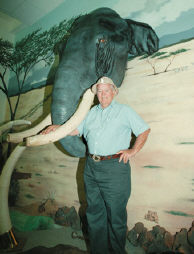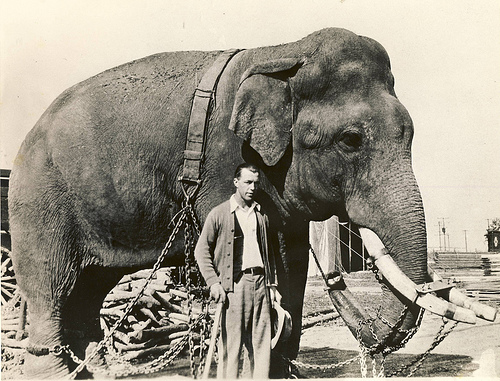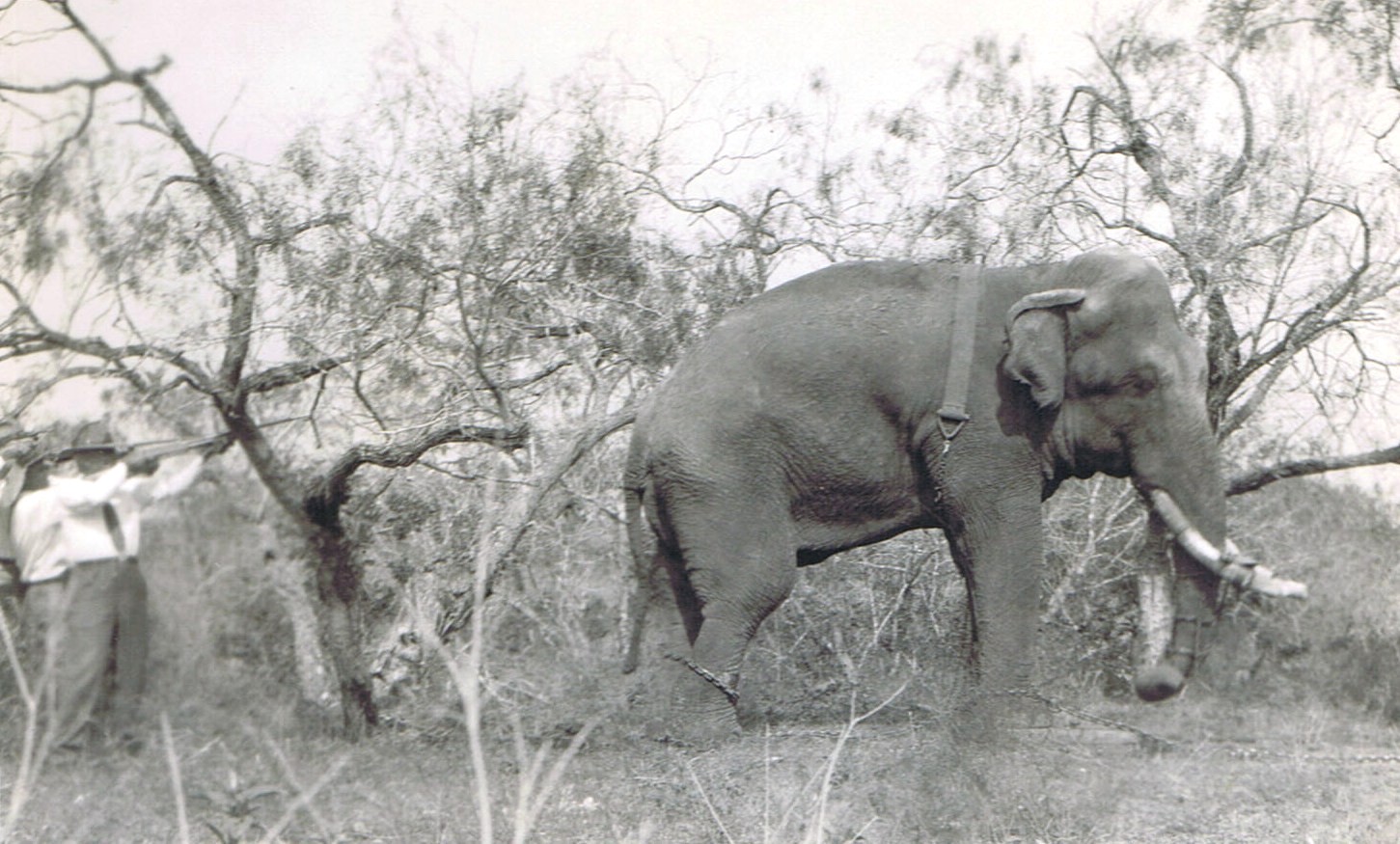See Eva Donohoe for her obituary and related articles
Black
Diamond
There had been a bounteous cotton harvest, nimble fingers of young and old, black and white, had picked the fluffy bolls of cotton. Money jingled in every pocket. The circus coming from the east on the Cotton Belt railroad was behind a wreck and was late in arriving. In fact, it was almost parade time; performers had to be ed and animals at least watered. In one of the metal-bottomed elephant cars was "Black diamond", the huge thirty-one-year old, nine-ton Indian elephant, believed to be the tallest in captivity, and at that time, owned by the Al G. Barnes Circus. He had been a dependable creature, working and performing without any difficulty. He had fits of temper. This reputation had caused Black Diamond to be chained to two docile female elephants whenever the circus paraded down the streets of a town. In addition, his tusks were sawed off in 1927, and an iron bar had been placed across to limit use of his trunk. He had been bought for three thousand dollars because he was known as a "Runaway" elephant. A trainer, H. D. (Curley) Pritchett, had known him for twenty-eight years and trained him for seven years before my aunt Eva Speed Donohoo, had hired him a year and a-half before, to oversee animals on "Shoestring" Plantation near Kerens, Texas. Mrs. Donohoo was a writer, and a sister of C. D. Speed, of Corsicana. She had been society editor of The Houston Post and a public stenographer in the Rice Hotel, Houston, Texas. She was widowed and had a daughter to support. At her father's death, she inherited part of the plantation and moved there to continue her writing of articles for newspapers under the She had hired Mr. Pritchett, who said he and his wife were tired of traveling, while Black Diamond swayed back and forth munching his hay. Mr. Pritchett had not seen the elephant again until he helped take him out of the boxcar in Corsicana, and he vowed Black Diamond hugged him with his trunk and shed tears on his head. Black Diamond had always been jealous of him, and would not allow his wife to lay her coat on his bunk. That particular day, my aunt was standing between the parked cars on First Avenue, where the School Administration building is now located. The circus lot was north about where the Navarro Mall is located. On that fatal day Black Diamond spied my aunt, tossed Mr. Pritchett over a car breaking his arm, and chewed his had, then striking my aunt knocking her to the street and butting cars over her body; he did not trample her. Three times she was pulled away, only to be dragged back by the elephant. Pandemonium reigned with all the circus hands and a man trying to save her. The superintendent of elephants galloped up on horseback, bringing a third female elephant to chain to Black Diamond. Finally he was subdued. My aunt was laid on the lawn until the ambulance came to take her to Corsicana Hospital, on Sixth Avenue, where she soon expired. Meanwhile Black Diamond, escorted by the three elephants and circus attendants, was taken to the lot, watered and returned to the boxcar and chained. He rocked the car, and trumpeted for hours. Finally he quieted somewhat, but refused food and water. Townspeople demanded his death, but circus officials demurred, saying he was still in a rage and dangerous to handle. The largest crowed ever to that date attended the two performances and were disappointed that the elephant that killed a woman was nowhere to Four days later, the Ringling Brothers, who were buying the Al. G. Barnes Circus, decided to kill Black Diamond, but how? Corpus Christi offered to drown him in the Gulf of Mexico. Circus officials thought of putting a circle of chains around his neck and having six elephants, three on each side, tighten chains and choke him to death. They used 1,200 grains of cyanide and a crate of oranges, his favorite food, and in peanuts. He touched neither. They decided he would have to be shot. At Kenedy, Texas, October 16, 1929, he was given circus parade call; he got in formation, and led by the three female elephants, was taken a mile west of town and was chained to three huge mesquite trees. A block was placed, and he put his forefeet thereupon; they were chained, and then the hind feet were chained. Sobbing circus people and a few townspeople stood nearby. Five expert marksmen sprayed 155 shots into him; he slumped, then one marksman put one shot into a vital spot, and he toppled and died, at 2:15 P.M. A huge hole had been dug, but tractors could not budge the 18,000 pound elephant. A man began to strip hide and sell it; a veterinarian from Houston, Texas, severed the head, mounted at the height Black Diamond stood, in the basement of the Museum of Science in Houston's Herman Park with the Notation "Black Diamond, circus elephant killer of a woman at Corsicana". She was his fourth victim. In Oakwood Cemetery in Corsicana on the Speed lot, there is a simple marker "Eva Speed Donohoo 1877-1929, Killed by Al G. Barnes Circus Elephant". Her daughter, (Louise Mahan) is dead. The daughter's son, W. D. Mahan, is a Judge at Pawhuska, Oklahoma. He had several children. Mr. Paul Moore wrote articles for The Daily Sun.
More on the Black Diamond Saga As a native of Corsicana, Texas, and an aficionado of Black Diamond, the allegedly 'rogue' elephant who killed Eva Speed Donohoo in 1929, I would like to add a detail to your information. Ms. Donohoo was not in fact merely an unconcerned bystander at the circus parade in which Black Diamond went 'berserk.' She had, there in Corsicana a year and a half previous, hired the elephant's long-time trainer away from the circus to oversee her plantation and its animals. What's more, she had negotiated his employment while standing in front of Black Diamond, who was eating his daily hay. More than a year later, the trainer returned to town from the plantation beyond the outskirts and helped to unload the circus animals, at which time he was reunited with Black Diamond who, he said later, seemed very moved to see him again (they'd known one another for 28 years). It was when the elephant spotted Ms. Donohoo in the crowd and recognized her that he broke loose from the procession, seeking revenge for his trainer's defection. One very smart titan. [Carol Dawson, 1/28/00]
12/21/2003 GUEST COMMENTARY: A Diamond in the Rough? If you live in Corsicana or the surrounding area and have not visited the Trophy Room at the Watkins Construction office, you have missed a treat. It is a "diamond in the rough," so to speak. The diamond that is referred to here is that of "Black Diamond," a circus elephant of the 1920s era whose head hangs on the back wall of the museum. The history behind Black Diamond was written and published in the Daily Sun a few years ago. Black Diamond's notoriety comes from the time the elephant charged and killed a local woman while the circus was visiting in the city. The museum has many interesting things for the young and old to see. One will find murals painted on the walls of places the owner, Carmack Watkins, has visited. He has traveled far and wide about this world that we live. If you are lucky to find Carmack in the office you will be treated to many interesting facts and stories based on what you see in the Trophy Room. I know that there will be some whose feelings are disturbed by the fact that so many animals were slain in order for their remains to be mounted in the room. It might help to know that the natives of the land in which these animals once lived took the meat to eat as soon as the animal "hit the ground." Carmack even explained that the bones of the animals were taken and used as tools (broom handles, axe handles, etc). In the Trophy Room one can find scenes that reenact nature's fierce battles between the inhabitants of the land. One such mounted treasure shows a king cobra locked in an embrace with a mongoose. It appears that the cobra is getting the better hand, but Carmack assured me that almost always the mongoose is the winner. Lions and tigers and bears, oh my! Not just any bear can be found, but polar, grizzly, black bears, you name it. All of these and many more can be found in the Trophy Room. Black rhinos, alligators, musk ox, leopards and even the skin of a huge anaconda can be found there. The Trophy Room was visited by several of my science classes while at Rice ISD. The students were studying about various food chains and the adaptations of the animals to acquire their prey and feed upon it. Carmack shared his knowledge of the animals in this respect. Students as well as their instructor learned of things not taught in text books. Carmack shared with the students how caribou used their rack to find food in the snow in extreme cold regions. He told of the adaptations of the caribou to survive the freezing cold in that area. He shared stories of the alligator and its adaptation for the water and its "special lures" that drew in the unsuspecting prey for his "chicken" dinner. One other story that Carmack shared with the students was of the difference in the ears of African elephants and the ears of elephants from India. He explained that the ears of the elephant are "radiators" that regulate body temperature. But wait, there's no reason for me to tell all this to you. Go see for yourself. It is worth the trip, believe me. Oh, the price? I forgot to tell you, didn't I? It is all for free. Mr. Watkins would appreciate it if you would sign the register as you enter, or leave, the museum. The Trophy Room is open during the work days of the week. It is a great family outing. You can go by yourself, but it is more fun to go with someone. The Trophy Room can be found where South 15th Street joins with Interstate 45. For more information on Black Diamond: Please go to "Black Diamond (elephant)" or "Trophy Room of Carmack Watkins, Corsicana, Texas" on the Internet. Several items are written about this elephant's rampage in Corsicana in 1929. A tombstone in Corsicana's Oakwood Cemetery reads: "Eva Speed Donohoo, Nov. 18, 1877-Oct. 12, 1929, Killed by Al G. Barnes Circus Elephant." ---------- Raymond "Bud" Osborne is a resident of Corsicana. Elephant Executed
|
 Forty years ago Saturday, October 12, 1929, was a crisp, sunshiny day in
Forty years ago Saturday, October 12, 1929, was a crisp, sunshiny day in 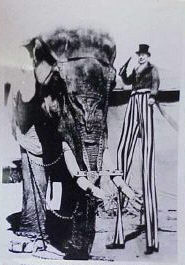 name of E. S. Donohoo.
name of E. S. Donohoo.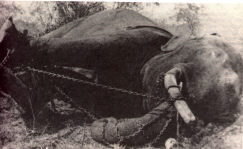 be seen.
be seen.